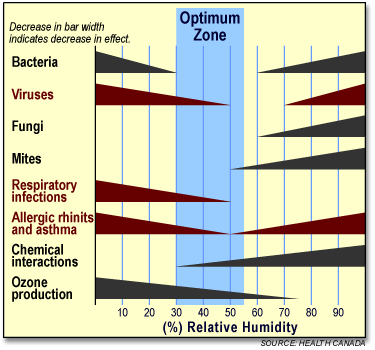Happy Holidays from all of us at AirPurifiersandFilters.com
Allergies and the Humidity in your Home
If your allergies are triggered by irritants in the home, you have probably experienced the effects of humidity levels that are too high or too low. Authorities such as the American Lung Association and the Canadian Mortgage and Housing Corporation (CMHC) are giving a great deal of attention to the issue of humidity in the home and how it affects indoor air quality as well as allergy and asthma sufferers. If your humidity is to low, you may want to investigate installing a furnace humidifier.
Respiratory Allergies and Humidity
The most common allergy-causing irritants in the home are those that are breathed in and then irritate the respiratory tract. Allergens such as mold spores, fungus, dust (dust mites) and pet dander are all affected by humidity.
When the relative humidity in the home is too high (>55%), it will create ideal conditions for the growth of bacteria, mold, fungus and for the reproduction of dust mites. Of course, as the populations of these allergens increase, your allergic reactions become more frequent and intensify.
When the relative humidity in the home is too low (<30%), allergens such as bacteria, mold and fungal spores, and the bodies and feces of dust mites dry out and blow into the air from which they are more readily inhaled by the allergy sufferer.
Dry air will further irritate allergy sufferers by drying the delicate membranes of the nose and respiratory tract, causing difficulty breathing, a sore irritated throat and snoring that can even trouble those who do not suffer from allergies.
The irritating effects of dry air can be especially hard on young children during the winter months, and pediatricians often recommend that parents humidify the air in childrens' rooms at night to relieve breathing problems and spontaneous nosebleeds.
Skin Allergies and Humidity
As winter progresses and humidity levels in the home drop, skin allergies can become increasingly troublesome. Already itchy, irritated skin is only made worse when dry household air tries to absorb what little moisture it has left.
Harvard Medical School recommends that skin be maintained at an ideal moisture level of 20-35%. In the winter, when "extreme environmental conditions can overwhelm the skin's natural protective barrier" - especially in homes that use "forced air heating systems" - it is more challenging to maintain a healthy level of moisture, and humidifying the air is recommended.

What Can You Do?
Fortunately, humidity issues in the home are quite simple to remedy. An inexpensive "hygrometer" (an instrument designed to measure the relative humidity of the air) can be used to identify potential problems.
Once you know that your air is either too dry or too humid, the purchase of a humidifier or dehumidifier is a simple solution. We have a few suggestions based upon our research and experience in humidifiers:
- We recommend a duct-mounted whole house furnace humidifier if you have a forced-air heating system
- Avoid "sponge" and evaporative pad type humidifiers, as the pads and sponges quickly lose evaporative efficiency in the presence of hard water minerals and sediments - this in turn causes the water to stagnate and for the pad and reservoir to become breeding grounds for mold and bacteria, making your problems worse
- Flow-through humidifier models are better than sponge and evaporative pad types, but they can waste large volumes of water and require frequent maintenance, especially if you have hard water
- Countertop or console-style humidifiers should ideally be equipped with UV sterilizers to kill the bacteria and other microbiological allergens that can build up in the water reservoirs (clean them regularly)
- No matter what brand or model you choose, maintain it to the manufacturer's specifications and clean it regularly.
- Regardless of which humidifier unit you select, you should be sure that it is equipped with a humidistat to allow for precise humidity control and to ensure that you do not over-humidify your living space.
AirPurifiersAndFilters.com recommends the Desert Spring furnace humidifier. This unit features a unique evaporative surface that maintains evaporative output even in the presence of hard water minerals, to ensure constant water turnover which in turn prevents water stagnation that could otherwise create bacterial or mold growth problems (this is a common problem in many other humidifiers). When equipped with the optional Desert Spring AutoFlush system (also recommended), this unit is the cleanest and best-performing humidifier we have ever tested. This model is designed to be mounted on the furnace of homes equipped with a forced air heating system.

